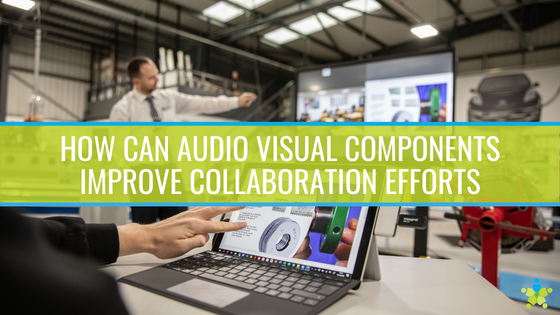[vc_row][vc_column][vc_column_text]There’s a lot of overlap between good communication and effective collaboration, and AV is focused on better communication solutions. Professional teams don’t collaborate like they used to, but audio/visual solutions have kept pace with those changes.
Millions of professionals have transitioned to remote work in just the last couple years, and this trend shows no sign of slowing down. AV collaboration hardware has been a critical part of this trend, allowing remote teams to work together as if they’re in the same room. Some of those AV collaboration solutions include:
- Video conferencing solutions
- Wireless presentation systems
- Interactive flat panels
- AV control surfaces
- Virtual meeting rooms
Together, these AV technologies can be used to enhance collaboration for a variety of spaces and for a variety of applications.[/vc_column_text][vc_column_text]
Stronger Collaboration Starts With Video Conferencing Solutions
In the modern world of collaboration, it starts with
video conferencing. It’s impossible to run a virtual or hybrid meeting without it, and even if all of your employees are in-house, video conferencing allows them to connect with each other from their own workstations.
Regarding video conferencing, the real question is what solution to choose. That depends on the size and layout of your space. A huddle room, for example, may require little more than an all-in-one conferencing bar like Poly’s Studio line of products.
A full-blown meeting room or auditorium, though, will need a scaled-up conferencing solution. Poly’s room or immersive telepresence products are one option. There’s also Zoom Rooms, which leverage the popularity and usability of the Zoom platform with hardware from reputable manufacturers.[/vc_column_text][vc_column_text]
Wireless Presentation Systems Allow Users To Collaborate With Their Own Devices
In the past few years, companies have prioritized easier connectivity, better cleanliness and faster meetings. Wireless presentation systems can support all three, and several manufacturers have expedited several such solutions to the market since 2020. Solutions that include
Crestron’s AirMedia, Mersive’s Solstice, Barco’s ClickShare and
Clevertouch Clevershare.
All four solutions allow users to walk into the room, connect their own device to the room’s technology and immediately begin presenting. Users can connect with a dongle - they only need to port it in, hit a button and follow the on-screen prompts. They can also connect through an app, again by following on-screen prompts.
Either way, as soon as the user is connected, they have control of the room’s conferencing equipment. They can start a call, set lighting and audio, and push content from their own device to the room’s display. It’s a more comfortable, more efficient way to spark collaboration.[/vc_column_text][vc_column_text]
Integrate An Interactive Flat Panel And Add Another Dimension To Your Meetings
Interactive flat panels may look like basic commercial displays, but they do much more than just display. Interactive flat panels like the Clevertouch allow people to add a tactile element to their meetings, which can make for more engaging collaboration.
How? An interactive flat panel allows the meeting presenter to effortlessly move through their presentation, using simple gestures to scrub through documents, slideshows, and media. Because the presenter doesn’t need to rely on their eyes to steer the meeting, they can focus on taking questions and suggestions from the other meeting participants.
Interactive flat panels can also be used to bring in media directly from the web. The
Clevertouch, for example, comes with a built-in browser that the presenter can use to incorporate images and videos. This can improve engagement and help the meeting’s other participants follow what’s going on better.[/vc_column_text][vc_column_text]
AV Control Surfaces Enable Room Scheduling And Better Room Management
AV control surfaces are used to manage a variety of AV technologies and solutions. They also make it easier for your teams to meet and begin collaborating.
Several brands produce
control surfaces, including Crestron and AMX. While some
AV controls still operate on tactile switches, most companies prioritize touchscreen control for their collaboration spaces.
There are a few reasons for this, including:
AV Control Surfaces Can Be Used With Any Room Technology
AV controls are designed to manage the kind of modern technologies you would find in a collaboration space. Whether it’s a huddle room or a full auditorium, AV control surfaces can manage all of its conferencing hardware, lighting and audio.
Every User Can Be Set Up With Their Own Configuration Profile
Everyone can set their preferences ahead of time, so with a single screen tap, each user can configure the lighting and audio, launch a call, and begin collaborating instantly.
AV Controls Can Make Room Scheduling And Reserving More Effective
Room scheduling and reservation software can improve collaboration by ensuring there’s adequate meeting space when your teams need it. AV controls enhance the impact of room scheduling initiatives and can prompt users for a password associated with their reservation, or set the room’s lighting and audio ahead of time.[/vc_column_text][vc_column_text]
Collaborate Anywhere, Even In Space, With Virtual Meeting Rooms
It may be a little while yet before we’re all meeting in virtual reality (VR), but some companies are already using it for their meetings. VR meeting software allows remote teams to meet in a shared virtual space, one that can be modeled to look like anything. Meet on the moon if that’s what your team wants to do.
Aside from the novelty, VR meetings give participants an array of collaborative tools that can greatly improve creativity and engagement. For instance, in a virtual meeting, any user can pop a whiteboard or any piece of media into existence at any time - as long as they have the permissions to do so. This makes for a free-flowing collaborative experience that’s particularly helpful for creative teams.[/vc_column_text][vc_column_text]
With audio visual components and solutions, there are a lot of ways to improve your organization’s collaboration. To get the most out of those solutions, though, you’ll need an integrator you can trust. In the AV industry, trust starts with industry certification and experience, and Data Projections can provide both for your team.[/vc_column_text][/vc_column][/vc_row]



